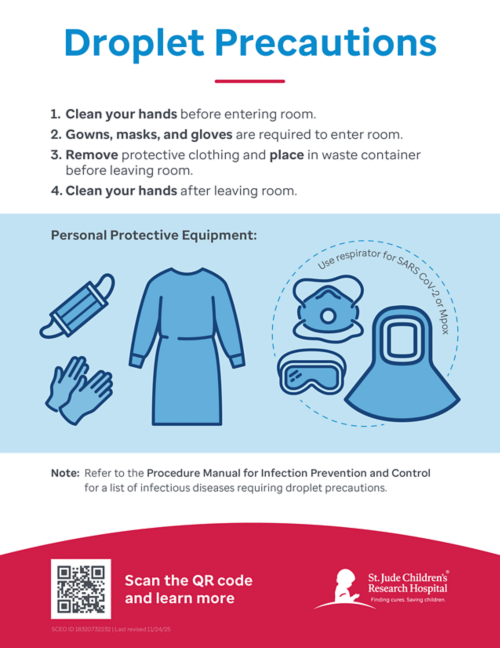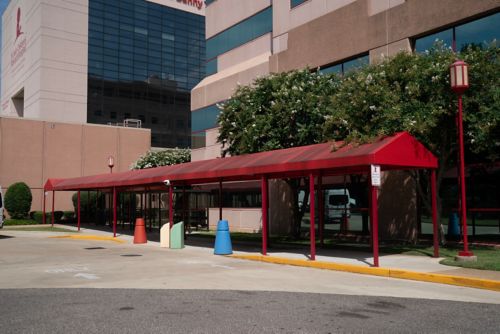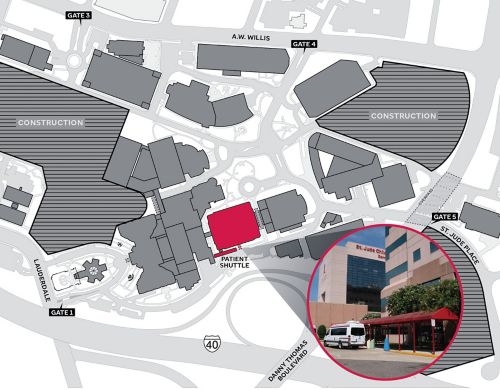Restrictive Isolation Precautions
What are restrictive isolation precautions?
Restrictive isolation precautions are special steps that you must take if your child has an infection that could spread to other St. Jude patients in the hospital. To lower the risk of spreading the infection, St. Jude must limit your child’s contact with other patients.
There are 2 types of restrictive isolation precautions:
- Droplet precautions: For germs spread by droplets, when your child coughs or sneezes
- Contact precautions: For when your child touches a surface where germs are spread by direct contact
If your child is an outpatient or inpatient, there will be isolation signs on their door for safety.
Your child will follow the type of precautions recommended by their care team, based on your child’s type of infection. You will need to take special steps if your child is under restrictive precautions and needs to come to St. Jude.
If your child is under either type of restrictive isolation precautions, you and your child will need private transport to and from the hospital. Do not use the St. Jude shuttle buses. If you do not have a vehicle in Memphis, St. Jude will arrange a shuttle or taxi just for you and your child. Call Patient Services at 901-595-4501 to arrange your housing and transport needs.
If you drive your own car, parking is offered in 3 lots near the Patient Care Center (PCC). Reserved spaces are also offered on the ground level of Parking Garage 1. Security guards at the entrance gate can direct you to that garage.
To reach the parking lots, enter through the North Lauderdale gate, located at 332 North Lauderdale Street, Memphis, TN. Take the first right. The parking lots are on your right. Look for the signs and park in any patient parking space. Please do not use valet parking or the shuttle service when in restrictive isolation.
After you park, follow the signs to enter the hospital through the PCC main entrance. You can also enter through the entrance with a red awning on the south side of the Danny Thomas Research Center.
- If you are staying at Tri Delta Place, it has its own parking lot. You may arrange a shuttle to the hospital by calling Housing and Patient Services at 901-595-4501. Please avoid walking across campus, because dust from the construction site poses a risk to patients. If you must walk to the hospital, have your child wear a face mask and enter through the PCC entrance.
- If your child is in restrictive droplet isolation precautions, please make sure that you and your child are wearing face masks before you enter the building. Face masks are available at each entrance.
- Use hand sanitizer when you enter, and walk directly to your first clinic appointment. A room assigned to you will be waiting for your arrival. If the clinic is not yet ready to receive you, you will be directed to a designated waiting area for patients in restrictive isolation. Please keep face masks on and maintain physical distancing from other families while your child is in isolation.
- While your child is in restrictive isolation, avoid common areas when possible. You will be able to go to Family Commons for school sessions only. Kay Kafe will have a designated area for your family to eat while maintaining a safe distance from others to prevent the spread of infections.
Preventing the spread of infection
The most important way to prevent the spread of infection is to clean your hands often. This means either washing well with soap and water or using alcohol gel.
For some infections, soap and water is the best way to remove certain germs. If your child has this type of infection, you might see a sign on the door that reads, “Cleaning hands with water and soap is required.”
Outpatient isolation precautions
If your child is an outpatient, you and your child may need to wear personal protective equipment (PPE) when going to certain areas. If your child is in:
- Restrictive droplet isolation: Both you and your child should wear a face mask. Ask your care team if a child under age 2 must wear a mask.
- Restrictive contact isolation: You and your child are not required to wear PPE unless you are asked otherwise.
Other guidelines for outpatients include:
- Your child must stay in the room when in a clinic. You should only wait in designated waiting spaces and should maintain physical distancing from others.
- Your child will wear a color-coded armband. If your child is in restrictive droplet isolation, they will wear a blue armband. A blue isolation sign will be on the door. If your child is in restrictive contact isolation, they will wear a purple armband. A purple isolation sign will be on the door. The sign will tell people what type of PPE to wear when in your child’s room.
- Staff and visitors must wear gowns, gloves, and masks when entering the room as shown on the signs posted on the room door. Gowns and gloves are outside the room but are thrown away inside the room before leaving the room.
- Clean hands before entering and after leaving the isolation room. Also, clean hands before and after using masks.
- Register with our concierge team. They can help you get lunch or pick up take-home supplies when you are in isolation. You can register with them using this enrollment form.
A member of our team will call you the day before your appointment to review isolation procedures with you and answer any questions that you may have.
Inpatient isolation precautions
- Your child must stay in the room. No visits to common areas, waiting rooms, or public events.
- You and your family should limit your trips to other parts of the hospital to avoid spreading your child’s infection. Never enter other patient rooms or have close contact with other patients or their parents.
- Wear gloves when touching soiled items in your child’s room. This includes emptying bedpans, helping your child to the toilet, handling urine or stool, or changing diapers. Wash your hands after removing gloves.
- Do not put food or drinks from your child’s room into refrigerators on the inpatient unit. This helps prevent germs from spreading through food storage areas.
- If you bring food from outside the hospital, place it in the Family Lounge refrigerator first. Then, you can take portions to your child’s room. Once food enters your child’s room, the uneaten part must be thrown away. It must not be put back in the refrigerator.
- Please have hospital room service deliver your child’s food when possible. This will reduce the risk of infection. Food from room service comes on throw-away trays. Flush leftover liquids down the toilet. To order food from room service, dial 901-595-3000. Have your MRN and selection from the menu ready when you call. Learn more about ordering to-go food.
- Limit the number of personal items in the room so that staff can clean surfaces well.
- Bring only solid-surface toys into the isolation room. They must be cleaned before they leave the room. Do not bring plush toys or stuffed animals.
- Place clothes in a personal belongings bag before removing them from the room. If possible, wash them in hot water with bleach.
- Anyone who is not a parent (caregiver) must wear the PPE as directed by the digital sign posted by the door. Because parents are in close contact with the child for long periods, they do not have to wear PPE while in their child’s room. But sometimes, parents must wear face masks in their child’s room for their protection. For some types of isolation, visitors and siblings are not allowed in the patient room.
- During transport within the hospital, both you and your child must wear a mask if in droplet isolation.
Isolation guidelines for housing
Sometimes, you can stay in the same St. Jude housing if your child is on isolation precautions. Other times, you may need to move to lower the risk of spreading infection.
Droplet isolation guidelines
Some types of germs (viruses and bacteria) are spread by droplets your child makes when they cough or sneeze. These droplets can touch a person or a surface. To prevent germs of this type from spreading, you must take droplet precautions.
- You and your child will be in a room or apartment with a door that opens to the outside if possible. This helps lower the risk of infection if your child sneezes or coughs because these droplets spread germs through the air.
- If you and your child need to leave the room, wear face masks.
- Avoid common areas. You and other family members may leave your St. Jude room if needed. Your child must not go to any common areas.
- Do not ride in an elevator with other patients or families.
- Do not ride in vehicles with other patients or families.
- Do not use public laundry facilities when others are present.
Contact isolation guidelines
Some kinds of germs are spread by touching infected patients or things that have germs on them. To prevent germs of this type from spreading, you must take contact precautions.
- Tri Delta Place, The Domino’s Village, and Target House: Usually you and your child can stay in a room or suite at Tri Delta Place with a door that opens to the inside of the building. Or you might stay in an apartment at The Domino’s Village or Target House. This depends on the type of infection your child has. If your child needs a room with an outside door and one is not available, you might be placed in a hotel.
- Ronald McDonald House: If you are staying in an apartment, you will continue to stay there. If you are in a room, you will move to other housing if possible. Please do not use the shared kitchen at Ronald McDonald House while your child is in isolation.
- Avoid common areas. You and other family members may leave your St. Jude room if needed. But your child must not go to any common areas. If your child does go into common areas during restrictive isolation, we may ask you to leave St. Jude housing and stay somewhere else.
- Do not touch surfaces. When going to and from the room, your child should not touch any surfaces, including walls or counters.
- Do not ride in an elevator or a vehicle with other patients or families.
- Do not use public laundry facilities when others are present.
Key points about restrictive isolation precautions
- Isolation precautions help lower the risk of spreading infection.
- There are 2 types of isolation precautions: droplet precautions (for infections spread through coughing or sneezing) and contact precautions (for infections spread through touching contaminated surfaces).
- When on restrictive isolation precautions, your child must stay in their room and avoid other patients and families.
- Cleaning hands often with soap and water or alcohol gel is essential. Masks, gloves, and/or gowns may be required depending on the infection type.
—
Reviewed: September 2025




